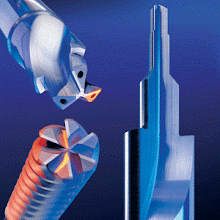When machining, it is necessary toknow the hardness of workpiece material beforehand.There are a number of methods in which hardness can be calibrated. Each method varies slightly, the main factors that varies is the force that is applied to a penetrating device that is pressed into the workpiece surface, and the geometry of the penetrating device. Below is an example of the 3 main calibration methods .
Rockwell hardness (HR)
The Rockwell hardness is determined by the depth of an impression left in the surface of a material after subjecting the penetrating device to a specific load. The units for the hardness is given as HRC (in the case of a C scale). Rockwell hardness is the scale that is most often used in machine workshops.
Table 2.2 shows four commonly used Rockwell scale.
Vickers hardness (HV)
The Vickers hardness is determined by the. size of a surface area of an impression left in a material after pressing the tip of a diamond square pyramid penetrating device into a test material. The hardness value is shown as OOOHY.
Srinell hardness (HB),



0 comments:
Post a Comment